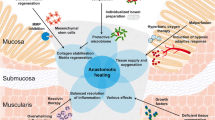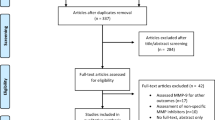Abstract
Background
Increased matrix metalloproteinase (MMP) activity has been implicated in the pathogenesis of colorectal anastomotic leakage. Tumor necrosis factor-α (TNF-α) induces MMPs and may influence anastomosis repair.
Methods
We assessed the efficacies of the nonselective hydroxamate MMP inhibitor GM6001, the selective hydroxamate MMP inhibitor AG3340 and a TNF-α antagonist with respect to anastomotic breaking strength of left-sided colon anastomoses in male Sprague–Dawley rats.
Results
Systemic GM6001 treatment effectively blocked MMP activity and maintained the initial breaking strength day 0 of the anastomoses when administered subcutaneously as daily depositions (100 mg/kg) or continuously (10 mg/kg/day). In contrast, the anastomotic biomechanic strength was lowered by 55% (p < 0.001) in vehicle-treated rats on postoperative day 3. GM6001 treatment increased breaking strength by 88% (p < 0.0005) compared with vehicle-treated rats day 3 and reduced (p = 0.003) the occurrence of spontaneous anastomotic dehiscence. Histologically, the anastomotic wound was narrower (p < 0.05) in the longitudinal direction in GM6001-treated animals whereas GM6001 had no significant effect on inflammatory cell infiltration or epithelialization. AG3340 (10 mg/kg) increased (p < 0.012) breaking strength by 47% compared with vehicle on day 3 but did not significantly prevent the reduction of the initial breaking strength on day 0. Although the increased TNF-α levels in the wound were attenuated, the anastomotic breaking strength was not improved (p = 0.62) by the TNF-α (10 mg/kg) inhibitor given systemically.
Conclusions
Pharmacological nonselective MMP inhibition ought to be explored as a prophylactic regimen to reduce anastomotic complications following colorectal resection. The involvement of TNF-α was insignificant in anastomotic wound healing in an experimental model.





Similar content being viewed by others
References
Frye J, Bokey EL, Chapuis PH, Sinclair G, Dent OF (2009) Anastomotic leakage after resection of colorectal cancer generates prodigious use of hospital resources. Colorectal Dis 11:917–920
Bertelsen CA, Andreasen AH, Jorgensen T, Harling H (2010) Anastomotic leakage after anterior resection for rectal cancer: risk factors. Colorectal Dis 12:37–43
Walker KG, Bell SW, Rickard MJ, Mehanna D, Dent OF, Chapuis PH, Bokey EL (2004) Anastomotic leakage is predictive of diminished survival after potentially curative resection for colorectal cancer. Ann Surg 240:255–259
Hendriks T, Mastboom WJ (1990) Healing of experimental intestinal anastomoses. Parameters for repair. Dis Colon Rectum 33:891–901
Syk I, Ågren MS, Adawi D, Jeppsson B (2001) Inhibition of matrix metalloproteinases enhances breaking strength of colonic anastomoses in an experimental model. Br J Surg 88:228–234
Ågren MS, Andersen TL, Mirastschijski U, Syk I, Schiødt CB, Surve V, Lindebjerg J, Delaissé JM (2006) Action of matrix metalloproteinases at restricted sites in colon anastomosis repair: an immunohistochemical and biochemical study. Surgery 140:72–82
Ågren MS, Andersen L, Heegaard AM, Jorgensen LN (2008) Effect of parenteral zinc sulfate on colon anastomosis repair in the rat. Int J Colorectal Dis 23:857–861
Stumpf M, Klinge U, Wilms A, Zabrocki R, Rosch R, Junge K, Krones C, Schumpelick V (2005) Changes of the extracellular matrix as a risk factor for anastomotic leakage after large bowel surgery. Surgery 137:229–234
Pasternak B, Matthiessen P, Jansson K, Andersson M, Aspenberg P (2010) Elevated intraperitoneal matrix metalloproteinases-8 and -9 in patients who develop anastomotic leakage after rectal cancer surgery: a pilot study. Colorectal Dis 12:e93–e98
Kiyama T, Onda M, Tokunaga A, Efron DT, Barbul A (2001) Effect of matrix metalloproteinase inhibition on colonic anastomotic healing in rats. J Gastrointest Surg 5:303–311
Ågren MS, Jorgensen LN, Delaissé JM (2004) Matrix metalloproteinases and colon anastomosis repair: a new indication for pharmacological inhibition? Mini Rev Med Chem 4:769–778
de Hingh IH, Siemonsma MA, de Man BM, Lomme RM, Hendriks T (2002) The matrix metalloproteinase inhibitor BB-94 improves the strength of intestinal anastomoses in the rat. Int J Colorectal Dis 17:348–354
Renkiewicz R, Qiu L, Lesch C, Sun X, Devalaraja R, Cody T, Kaldjian E, Welgus H, Baragi V (2003) Broad-spectrum matrix metalloproteinase inhibitor marimastat-induced musculoskeletal side effects in rats. Arthritis Rheum 48:1742–1749
Ishimura K, Moroguchi A, Okano K, Maeba T, Maeta H (2002) Local expression of tumor necrosis factor-alpha and interleukin-10 on wound healing of intestinal anastomosis during endotoxemia in mice. J Surg Res 108:91–97
Mirastschijski U, Johannesson K, Jeppsson B, Ågren MS (2005) Effect of a matrix metalloproteinase activity and TNF-alpha converting enzyme inhibitor on intra-abdominal adhesions. Eur Surg Res 37:68–75
Matsumoto H, Koga H, Iida M, Tarumi K, Fujita M, Haruma K (2006) Blockade of tumor necrosis factor-alpha-converting enzyme improves experimental small intestinal damage by decreasing matrix metalloproteinase-3 production in rats. Scand J Gastroenterol 41:1320–1329
de Meijer VE, Sverdlov DY, Popov Y, Le HD, Meisel JA, Nose V, Schuppan D, Puder M (2010) Broad-spectrum matrix metalloproteinase inhibition curbs inflammation and liver injury but aggravates experimental liver fibrosis in mice. PLoS One 5:e11256
Shalinsky DR, Brekken J, Zou H, McDermott CD, Forsyth P, Edwards D, Margosiak S, Bender S, Truitt G, Wood A, Varki NM, Appelt K (1999) Broad antitumor and antiangiogenic activities of AG3340, a potent and selective MMP inhibitor undergoing advanced oncology clinical trials. Ann NY Acad Sci 878:236–270
Hande KR, Collier M, Paradiso L, Stuart-Smith J, Dixon M, Clendeninn N, Yeun G, Alberti D, Binger K, Wilding G (2004) Phase I and pharmacokinetic study of prinomastat, a matrix metalloprotease inhibitor. Clin Cancer Res 10:909–915
Witte MB, Thornton FJ, Kiyama T, Efron DT, Schulz GS, Moldawer LL, Barbul A (1998) Metalloproteinase inhibitors and wound healing: a novel enhancer of wound strength. Surgery 124:464–470
Mirastschijski U, Haaksma CJ, Tomasek JJ, Ågren MS (2004) Matrix metalloproteinase inhibitor GM 6001 attenuates keratinocyte migration, contraction and myofibroblast formation in skin wounds. Exp Cell Res 299:465–475
Christensen H, Andreassen TT, Oxlund H (1992) Age-related alterations in the strength and collagen content of left colon in rats. Int J Colorectal Dis 7:85–88
Sassi ML, Eriksen H, Risteli L, Niemi S, Mansell J, Gowen M, Risteli J (2000) Immunochemical characterization of assay for carboxyterminal telopeptide of human type I collagen: loss of antigenicity by treatment with cathepsin K. Bone 26:367–373
Garnero P, Ferreras M, Karsdal MA, Nicamhlaoibh R, Risteli J, Borel O, Qvist P, Delmas PD, Foged NT, Delaissé JM (2003) The type I collagen fragments ICTP and CTX reveal distinct enzymatic pathways of bone collagen degradation. J Bone Miner Res 18:859–867
Verhofstad MH, Lange WP, van der Laak JA, Verhofstad AA, Hendriks T (2001) Microscopic analysis of anastomotic healing in the intestine of normal and diabetic rats. Dis Colon Rectum 44:423–431
Seifert WF, Wobbes T, Hendriks T (1996) Divergent patterns of matrix metalloproteinase activity during wound healing in ileum and colon of rats. Gut 39:114–119
Shaper KR, Savage FJ, Hembry RM, Boulos PB (2001) Regulation of matrix metalloproteinases in a model of colonic wound healing in a rabbit. Dis Colon Rectum 44:1857–1866
Vaalamo M, Karjalainen-Lindsberg ML, Puolakkainen P, Kere J, Saarialho-Kere U (1998) Distinct expression profiles of stromelysin-2 (MMP-10), collagenase-3 (MMP-13), macrophage metalloelastase (MMP-12), and tissue inhibitor of metalloproteinases-3 (TIMP-3) in intestinal ulcerations. Am J Pathol 152:1005–1014
Lokuta MA, Huttenlocher A (2005) TNF-alpha promotes a stop signal that inhibits neutrophil polarization and migration via a p38 MAPK pathway. J Leukoc Biol 78:210–219
Reunanen N, Li SP, Ahonen M, Foschi M, Han J, Kähäri VM (2002) Activation of p38 alpha MAPK enhances collagenase-1 (matrix metalloproteinase (MMP)-1) and stromelysin-1 (MMP-3) expression by mRNA stabilization. J Biol Chem 277:32360–32368
Ipaktchi K, Mattar A, Niederbichler AD, Hoesel LM, Hemmila MR, Su GL, Remick DG, Wang SC, Arbabi S (2006) Topical p38 MAPK inhibition reduces dermal inflammation and epithelial apoptosis in burn wounds. Shock 26:201–209
Zubaidi A, Buie WD, Hart DA, Sigalet D (2010) Temporal expression of cytokines in rat cutaneous, fascial, and intestinal wounds: a comparative study. Dig Dis Sci 55:1581–1588
Salmela MT, Pender SL, Karjalainen-Lindsberg ML, Puolakkainen P, Macdonald TT, Saarialho-Kere U (2004) Collagenase-1 (MMP-1), matrilysin-1 (MMP-7), and stromelysin-2 (MMP-10) are expressed by migrating enterocytes during intestinal wound healing. Scand J Gastroenterol 39:1095–1104
Sachsenberg-Studer EM, Runne U, Wehrmann T, Wolter M, Kriener S, Engels K, Elshorst-Schmidt T, Kaufmann R, Borradori L (2001) Bullous colon lesions in a patient with bullous pemphigoid. Gastrointest Endosc 54:104–108
Lund LR, Rømer J, Bugge TH, Nielsen BS, Frandsen TL, Degen JL, Stephens RW, Danø K (1999) Functional overlap between two classes of matrix-degrading proteases in wound healing. EMBO J 18:4645–4656
Sinnamon MJ, Carter KJ, Fingleton B, Matrisian LM (2008) Matrix metalloproteinase-9 contributes to intestinal tumourigenesis in the adenomatous polyposis coli multiple intestinal neoplasia mouse. Int J Exp Pathol 89:466–475
Jensen SA, Vainer B, Bartels A, Brünner N, Sørensen JB (2010) Expression of matrix metalloproteinase 9 (MMP-9) and tissue inhibitor of metalloproteinases 1 (TIMP-1) by colorectal cancer cells and adjacent stroma cells—associations with histopathology and patients outcome. Eur J Cancer 46:3233–3242
Wagenaar-Miller RA, Gorden L, Matrisian LM (2004) Matrix metalloproteinases in colorectal cancer: is it worth talking about? Cancer Metastasis Rev 23:119–135
Balcom JH, Keck T, Warshaw AL, Antoniu B, Lauwers GY, Fernandez-del Castillo C (2002) Perioperative matrix metalloproteinase inhibition therapy does not impair wound or anastomotic healing. J Gastrointest Surg 6:488–495
Mirastschijski U, Impola U, Karsdal MA, Saarialho-Kere U, Ågren MS (2002) Matrix metalloproteinase inhibitor BB-3103 unlike the serine proteinase inhibitor aprotinin abrogates epidermal healing of human skin wounds ex vivo. J Invest Dermatol 118:55–64
Acknowledgments
Michael Engsig was helpful in initiating this project. This research has been supported by a Marie Curie Fellowship of the European Community program Human Potential under contract number HPMF-CT-2001-01429, the Danish Medical Research Council (22-02-0287), and LEO Pharma.
Author information
Authors and Affiliations
Corresponding author
Rights and permissions
About this article
Cite this article
Ågren, M.S., Andersen, T.L., Andersen, L. et al. Nonselective matrix metalloproteinase but not tumor necrosis factor-α inhibition effectively preserves the early critical colon anastomotic integrity. Int J Colorectal Dis 26, 329–337 (2011). https://doi.org/10.1007/s00384-010-1106-3
Accepted:
Published:
Issue Date:
DOI: https://doi.org/10.1007/s00384-010-1106-3




